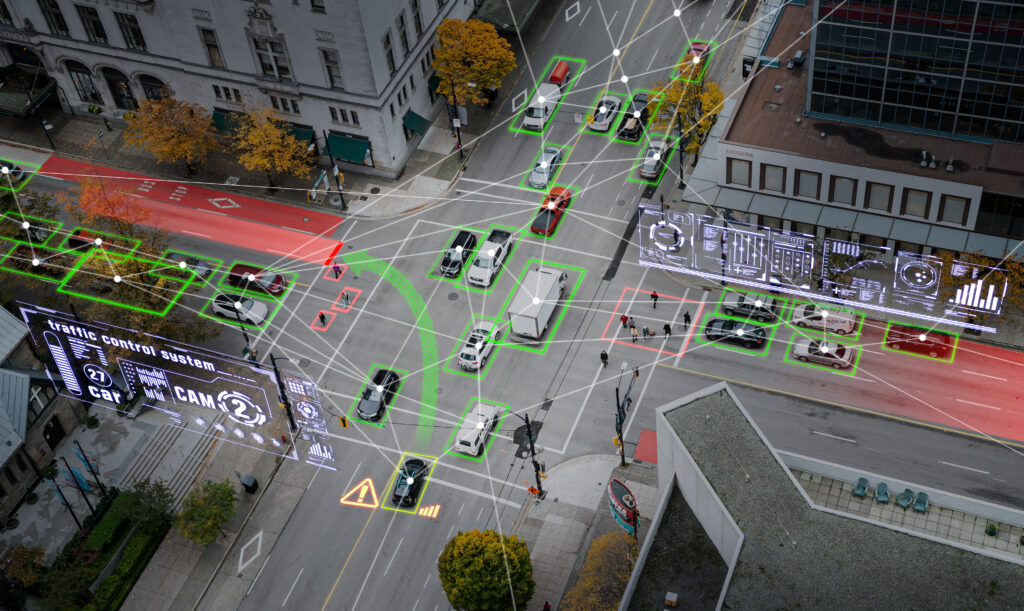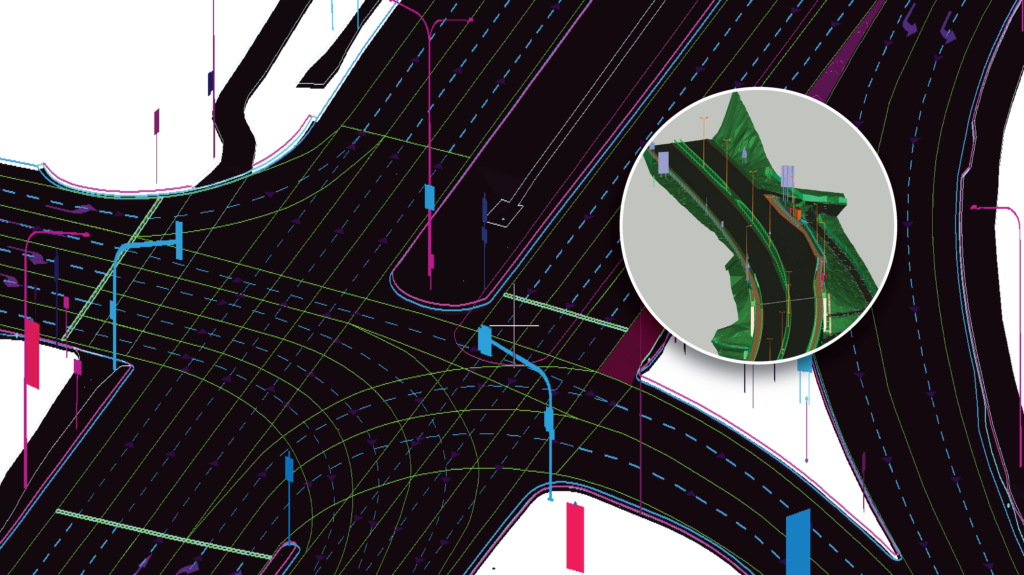The landscape of transportation infrastructure in the United States is at a crucial juncture. With the advent of the Infrastructure Investment and Jobs Act (IIJA), state Departments of Transportation (DOTs), rail authorities, and local transportation agencies are poised at the brink of a transformative era. Escalating challenges and evolving opportunities mark this period – from bolstering infrastructure resilience and adapting to vehicle electrification to optimizing asset maintenance and expanding Environmental, Social, and Governance (ESG) as well as Diversity, Equity, and Inclusion (DEI) initiatives. In this context, integrating geospatial services – encompassing Digital Twins, LiDAR, drone technologies, mobile mapping, machine learning, and more – emerges as a pivotal element in redefining the future of transportation.
Transportation agencies today are grappling with aging infrastructures, increasing environmental concerns, and the urgent need for technological adaptation. The shift towards sustainable and resilient infrastructure demands innovative approaches and advanced analytical capabilities.
A key challenge in modernizing transportation infrastructure is the accurate mapping and management of existing assets and features. This includes everything from road surfaces and signage to underground utilities and traffic control systems. Effective asset mapping is crucial for maintenance, planning, and the successful integration of new technologies. However, many agencies struggle with outdated or incomplete data, making it difficult to get a comprehensive view of their infrastructure and identify areas needing upgrades or repair.
The Infrastructure Investment and Jobs Act (IIJA) presents a monumental opportunity for infrastructure revitalization. However, this opportunity comes with the responsibility of judicious fund allocation and project prioritization. Agencies face the complex task of ensuring long-term, sustainable benefits from these investments, aligning them with broader goals such as public safety, environmental sustainability, and improved urban mobility while ensuring equitable resource distribution.
The emergence of electric vehicles (EVs) and autonomous vehicles (AVs) introduces new challenges. The transition to EVs requires the development of widespread charging infrastructure and grid modernization to accommodate increased electricity demands. For AVs, infrastructure must evolve to support advanced signaling systems and vehicle-to-infrastructure communication, necessitating technological upgrades, significant data integration, and enhanced security measures.
These future-focused developments require an anticipatory approach to infrastructure planning, accommodating technological advancements in both current and future projects and adapting not just physical structures but also regulatory and safety frameworks.

Facing the challenge of aging infrastructure and the need for scalable solutions, Digital Twins and LiDAR technologies emerge as transformative tools. Digital Twins, with their dynamic modeling and simulation capabilities, are pivotal in adapting to urban expansion and environmental pressures. They enable agencies to predict and plan for future scenarios effectively. Meanwhile, LiDAR’s precision in mapping and surveying is essential for accurate assessment and redevelopment of existing infrastructures, addressing the gaps in current asset and feature mapping.
As transportation networks expand into more complex and hard-to-reach areas, drone technology and mobile mapping offer solutions. Drone technology revolutionizes data collection, providing extensive coverage vital for managing expanding and intricate networks. Mobile mapping complements this by bringing enhanced detail and efficiency, which is crucial for the maintenance and monitoring of these evolving transportation infrastructures.
With the shift towards sustainable infrastructure and the need to integrate advanced technologies like EVs and AVs, machine learning algorithms are redefining maintenance strategies. They enable predictive maintenance, identifying potential issues before they escalate. This proactive approach is key in minimizing downtime and extending the lifespan of assets, ensuring that transportation systems are not only more efficient and sustainable but also capable of adapting to the demands of future technological developments.
The challenge centered on enhancing the efficiency and precision of road engineering and design processes in response to evolving transportation demands within a dynamically changing infrastructure landscape.
Magnasoft’s approach to transforming the city’s road network involved:
Creating Accurate 3D Models with LiDAR: Utilizing LiDAR-captured data, Magnasoft constructed precise 3D models for approximately 1000 linear kilometers of the city’s road network, encompassing detailed surroundings.
LiDAR Data Classification with Flexible Tolerance: The project featured a classification system for LiDAR data, with flexible tolerance levels ranging from 0% to 3%, ensuring high precision in mapping and modeling.
Establishing Smart Data Attributes: The resulting models were enriched with smart data attributes, providing a comprehensive and dynamic view of the road infrastructure.
Conducting Visual Inspections: These models facilitated comprehensive visual inspections, aligning as-built information with the original designs for a realistic and complete road view.
Developing an Integrated Database: Magnasoft created a user-friendly, accessible database that offered a complete historical and current view of the road infrastructure, aiding in efficient project management and decision-making.
This solution not only streamlined the city’s road network planning and development but also set a benchmark for future projects in road infrastructure management.

Network Planning for Electrification Infrastructure
As the push for vehicle electrification gains momentum, the role of geospatial technologies in planning and implementing EV infrastructure becomes crucial. From locating charging stations to analyzing grid capacity, the tools are in place to support this green transition.
Scaling ESG and DEI Efforts
Geospatial data is also vital in ensuring transportation projects align with ESG and DEI goals. Whether assessing environmental impacts or guaranteeing equitable access to transportation services, these technologies provide the insights needed for informed decision-making.
The Future of Transportation Infrastructure Monitoring and Maintenance
Incorporating these advanced geospatial tools into the everyday operations of transportation agencies could revolutionize how infrastructure is monitored, maintained, and developed. It promises enhanced safety, efficiency, and sustainability, aligning with the evolving demands of society and the environment.
The convergence of EV and AV technologies presents unique challenges and opportunities. For instance, EV charging infrastructure must be planned with the future of autonomous vehicles in mind. Geospatial technologies provide the analytical power to envision and plan for this integrated future.
Combined Data Analysis for EV and AV Infrastructure: As cities and regions plan for EVs and AVs, geospatial technologies can help analyze and integrate relevant data. This holistic approach ensures that infrastructure planning and implementation are future-proof and cater to the needs of both technologies.
Predictive Analytics for Demand and Usage Patterns: Understanding how EVs and AVs will be used in the future is crucial for effective infrastructure planning. Geospatial tools enable predictive analysis of potential demand and usage patterns, informing better decision-making.
In the transformative era of transportation, integrating geospatial technologies has become essential, unlocking revolutionary possibilities from advanced EV infrastructure to autonomous vehicle mapping. This evolution towards a more connected, intelligent infrastructure shapes a future where efficiency, sustainability, and responsiveness are paramount. Magnasoft stands at the forefront of this change, leveraging its expertise in geospatial data and technologies to transform challenges into opportunities, paving the way for a safer, smarter, and more sustainable transportation landscape.
Are you ready to take the next step in transforming your transportation infrastructure? Magnasoft is here to guide you through this journey. With our comprehensive suite of geospatial solutions – from Digital Twins and LiDAR technology to advanced drone and mobile mapping services – we are committed to helping you unlock the full potential of your transportation projects.
Explore Our Solutions: Uncover the potential of our advanced geospatial technologies for your projects.
Tailored Strategies: We customize solutions to meet your unique challenges.
Join the Future of Transportation: Partner with us to lead in creating efficient, sustainable, and smart transportation systems.
Ready to Embark on the Journey?
🌐 Contact Us: https://www.magnasoft.com/talk-to-us/
📧 Email Us: info@magnasoft.com